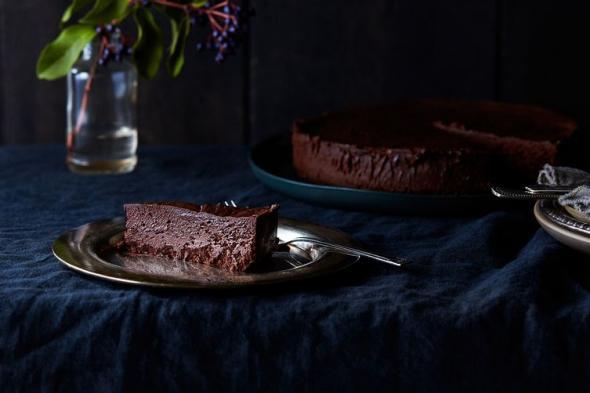This post originally appeared on Food52.
This flourless chocolate torte is a better and purer vehicle for chocolate than chocolate itself (scientifically speaking).
It’s made from just three ingredients: chocolate, butter, eggs. It takes less time to mix together than your average cookie, and it only bakes for 15 minutes.
So why did it at first seem scary, when in fact it took no more skill than the next chocolate cake? Why was I emailing the torte’s creator, Rose Levy Beranbaum, pictures of the cracked surface of my torte, only to slice into it later to find it was perfectly smooth and delicious inside?
Beranbaum’s recipes are famously precise, but, as I found out, it’s not because there’s only one way to get them right. It’s because she tests them until she finds the most proven path to making them the best that they can be.
I couldn’t just accept my gravity-defying, gluten-defying, failure-defying mousse cake—I wanted to know the reasoning behind each carefully plotted step. How necessary was each of her prescriptions, and what was the worst that could happen if I (or—no offense—you) botched one?
Below is a deep dive into the science and stories behind the recipe—with each ingredient and step annotated by Beranbaum herself. Feel free to skip to the recipe if you want to get to the goods sooner (I know, Valentine’s Day is upon us), but if you like food science, chocolate, or behind-the-scenes tales from the food industry of 1988, this long read is for you.
Happy Valentine’s Day, from RLB and me to you.
The History of the Chocolate Oblivion
Kristen Miglore: First off, tell me the story behind this torte—how did you start making it?
Rose Levy Beranbaum: There were two places where I had truffle tortes of this type. One was actually called a truffle torte—it was from Bonnie Stern, Toronto’s top cooking school teacher. When I went to meet her—it was a lot of years ago—she had this cake that she’d made, and I really loved it. And then I started investigating, and Narsai David also had a truffle-type torte—but it had one tablespoon of flour in it.
I made it and I thought it was really wonderful, but what was that one tablespoon necessary for? I think what he was doing was what so many people used to do in those days—they would put one unnecessary ingredient in something, so that if somebody imitated it, that person would know that it was being ripped off without credit. Isn’t that interesting?
I love giving credit, because I think giving credit has to do with the kind of food history that interests me. And it’s so nice to give credit—it doesn’t take anything away from you!
And then I came up with the idea—because I had been working on cheesecakes and I always hated the drier outside edge, I was using a water bath to keep the edges from drying. I thought if I apply that to this cake, then it will maybe the same moistness on the outside as it does in the center.
That was my starting point, having experienced these two. And they were called truffle tortes because they’re really like a truffle—although truffle is just heavy cream, some people add egg yolk or butter, but it’s basically ganache. This is like a ganache cake.
So that tablespoon of flour really isn’t doing anything?
Nothing I could find that was desirable … except to make it not suitable for the gluten intolerant!
You say this is your favorite way to eat chocolate. Why do you love it so much?
It’s the purest form of chocolate—when you just have a chocolate bar, you can’t taste the chocolate until it starts melting in your mouth. But this is just the right texture so that the minute you put it in your mouth, the flavors start exploding.
It’s the right consistency and there’s nothing to interfere. There’s no flour. Egg gives it texture, but it also enriches it further—it gives it a fuller flavor. And then of course butter doesn’t do any harm either!
This is a very, very special cake to me, not just because I don’t think chocolate gets better than this, but because of all the history I have around it.
[Note: The Oblivion has shown up in a birthday cake commissioned for Barbara Kafka’s mother, a friendly challenge to Gael Greene, and Rose’s first meeting with her life-changing assistant Woody, who she thought made the cake better than she did. It was also the source of Rose’s only real hate letter—the person complained it didn’t set, which is impossible given the large amount of chocolate and butter that sets even at room temperature.]
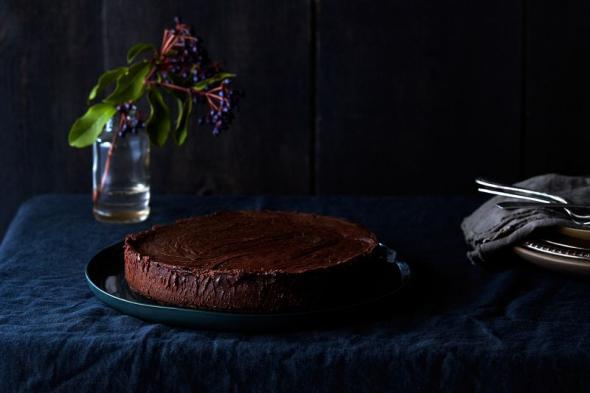
Julia Garrtland
That Name: Chocolate Oblivion Truffle Torte
How did you come up with the name?
My friend Marcel Desaulniers had just written Death by Chocolate, so we were making fun of all the extreme descriptions of chocolate, and I thought that Oblivion was the ultimate. I guess it makes you oblivious to everything else! It just seemed right.
I love naming things. The ultimate honor that I’ve ever been given was two weeks ago. My editor in China is having her first child, and she said “I would like to give you the honor of giving her her English name.” Isn’t that amazing? I get the chills just saying it.
What makes this a torte and not a cake?
Well, I think of a cake as having flour in it. It’s also not tall or tiered; it’s a single layer—so to me it was more of a torte.
Let’s Get Technical: The Ingredients
bittersweet chocolate (no higher than 62%) | 5⅓ 3-ounces bars | 1 pound | 454 grams
Why should the chocolate be no higher than 62 percent? What if I can only find 70 percent?
There’s more cocoa butter, and cocoa butter sets both in the refrigerator and room temperature, so it makes it stiffer, or firmer. Of course, once it softens, it will melt in your mouth, but I like it to melt in my mouth immediately.
What are your favorite brands to make this with now?
I no longer love Lindt as much as I did—it’s changed so much over the years. Chocolates that I love now are (not necessarily in this order): Scharffen Berger, Valrhona, Guittard, and Felchlin—those are favorites of mine.
Your favorite chocolate is to eat is what you should use in this torte, because even though it cooks and has other ingredients, its essential flavor is the chocolate that you use.
butter, unsalted, room temperature | 1 cup | ½ pound (2 sticks) | 227 grams
Why is room temperature of the butter important?
If you’re using cold butter, it will take longer to soften and the chocolate may be heating more than you want it to at that point.
And what would happen if the chocolate overheats?
It might affect the initial texture, the way it emulsifies with the eggs. It wouldn’t be as smooth. [Note: This is probably what happened to me, with my cracked top referenced above. It still tasted good!]
6 large eggs, room temperature | 1¼ scant liquid cups | 10.5 ounces | 300 grams (out of the shell)
What about the eggs—since you’re heating them up on their own later anyway, can you use them straight out of the fridge?
While you’re taking out the butter, you might as well take out the eggs—but you don’t have to. It’s fine to just do it cold, it will only add a little time to the heating. You’re right, you’re warming the eggs up anyway, they really don’t have to be room temperature.
The Steps
1) Preheat the oven to 425°F.
I’m assuming you prefer high heat for 15 minutes, rather than other similar flourless chocolate cakes that call for lower heat for much longer?
I do think it would work doing it at a lower temperature for a longer amount of time, but since it worked so perfectly at the higher temperature, I kept it that way.
2) In a large heat-proof bowl set over a pan of hot, not simmering water (do not allow the bottom of the bowl to touch the water) place the chocolate and butter and allow it to stand, stirring occasionally, until smooth and melted. (You can also use a microwave on higher power, stirring every 20 seconds.)
Why is it important that the water not simmer (and why can’t the bowl touch the water)?
Just as a general principal—it’s not a good idea to heat any chocolate mixture with steam. Before the butter’s all mixed in, steam could cause the chocolate to seize and then it’s hard to get it to be smooth again.
I know Alice Medrich actually melts chocolate by putting the bowl directly in the water—I would hesitate to tell people to do that because if they splash any water in that’s the end of it. She does caution people to be really careful.
So there are a lot of different feelings about melting chocolate depending on who you talk to. That’s why I’m saying I think it probably wouldn’t hurt, but my preference is for evenness.
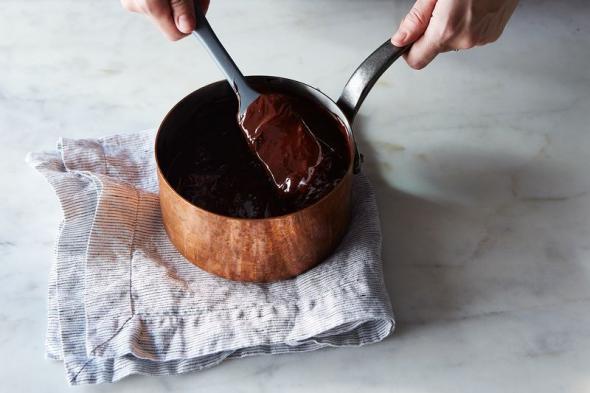
Julia Garrtland
And why is a microwave okay? Isn’t that potentially more aggressive than simmering water?
You know, I don’t really love doing it in the microwave, and there are two reasons. One is that it’s too much chocolate to melt well. And the other is that the microwave loves fat, so it will melt the butter and it could scorch the chocolate, unless you keep stirring religiously. So I think this is something that’s better made not in the microwave.
That actually is a good thing to talk about—which of these are the deal breakers for the recipe? Will you get a fairly good product at the end even if you break all of your rules? Or are there certain things that will dramatically affect the outcome?
I guess the biggest deal breaker is scorching the chocolate, because that will ruin the flavor of it. And not beating the eggs enough, because then you won’t have the moussey texture—but it’s not going to be devastating, it just won’t be as wonderful. And of course one of the biggest things is don’t use cheap chocolate.
I’ll never forget, when I went to the Lower East Side years ago to get Lindt chocolate, because that was the only way that you could get a large quantity that was affordable, and the little old man said to me “Vat are you making with this chocolate?” I said “Oh, I’m baking with it.” And he said,“But this is eating chocolate!” I said, “Well, don’t you eat what you bake?” He said, “You have a point!”
To me, I don’t want good enough, I want it to be as good as it can be.This is one thing, as you’ve discovered, that is good enough even if you don’t do it quite the way I had said to do it. But I prefer to have it come out the way I think is the ultimate, even though I think it’s hard to mess up.
3) In a large mixer bowl, set over a pan of simmering water, heat the eggs, stirring constantly with a wire whisk, until just warm to the touch. Immediately remove the bowl to the stand mixer and with the whisk attachment on high speed, beat about 5 minutes, until triple in volume and the eggs are billowy and lighter in color. (If using a handheld electric mixer, beat the eggs over simmering water until they are hot. Then remove them from the heat and beat for about 5 minutes or until cold.)
Why bother bringing up the temperature from hot-but-not-simmering to simmering just for the egg part of it?
Just because it’s faster, and because there’s no harm in the steam like there is for the chocolate.
You say that heating the eggs helps them grow more in volume as they’re whipped—why is that?
I have to tell you that when I was working on génoise for the Cake Bible—not heating the bowl versus just heating the eggs—all of that made a huge difference in the volume. I guess the heat enables it to expand—it’s like what happens during baking.
4) Use a large wire whisk or rubber spatula to fold half the eggs into the chocolate mixture until almost evenly incorporated. Fold in the remaining eggs until almost no streaks remain. Use a rubber spatula to finish folding, scraping up the mixture from the bottom to ensure that all the heavier chocolate mixture gets incorporated.
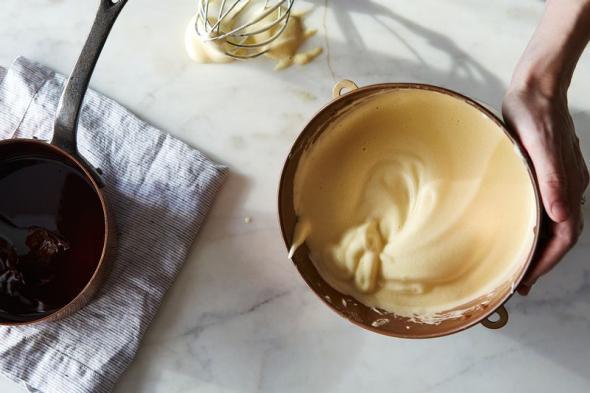
Julia Garrtland
Does it matter if you fold the chocolate into the eggs instead?
I do them both ways and there’s no difference regarding adding eggs to the chocolate or vice versa.
5) Scrape the mixture into the prepared pan and set it in the larger pan. Place it in the oven and surround it with 1 inch of hot water. Bake for 5 minutes. Cover it loosely with a sheet of buttered foil and bake another 10 minutes. (It will wobble when moved.) Remove the cake pan from the water bath and allow it to cool for about 45 minutes. Cover tightly with plastic wrap and refrigerate it until very firm, at least 3 hours.
What does the water bath do? What’s at work there?
It keeps the temperature equal, and it keeps it moister on the sides, because you’re introducing moisture during the baking. It’s really affecting the top more, and then whatever it does on the top is going to work its way down, so it will improve the entire texture. Also it is essential to use a double layer of heavy duty aluminum foil or water will seep in to the springform pan and then into the cake.
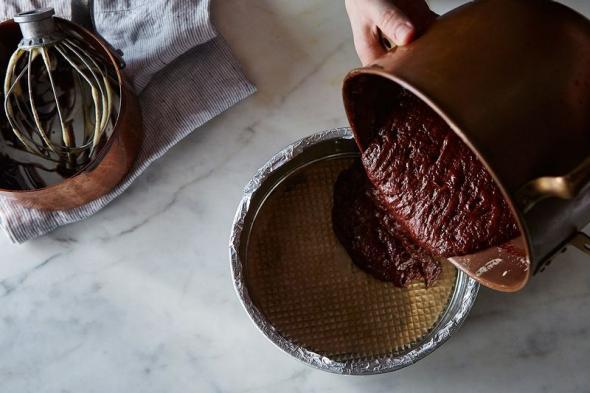
Julia Garrtland
Why cover it after the first five minutes?
That’s because you’re using a really high heat and you don’t want it to either dry out or burn.
Why buttered foil?
Just in case it dips down, so it doesn’t stick. Only recently I started saying that instead of using foil you can use a pot lid if it’s heatproof, to cover it. Because that’s kind of convenient, and then if it’s a glass one, you can see through it.
6-9) Unmold the cake: Have ready a serving plate that has at least an 8-inch flat center portion and an 8-inch or large flat loose bottom of a tart pan or plate, covered with greased plastic wrap. Run a torch, hair dryer, or a hot damp towel around the sides of the pan. Run a thin metal spatula around the sides of the torte and release the sides of the springform pan. Place the plastic-wrapped plate on top and invert the torte onto it. Heat the bottom of the pan and remove it. Peel off the parchment and reinvert the torte onto the serving plate. Serve: Cut the torte, using a thin-bladed knife dipped in hot water between each slice. Accompany with raspberry sauce and fresh raspberries and whipped cream if desired.
You offer a lot of serving and frosting suggestions in the Cake Bible—ganaches and buttercreams—what would you serve it with now?
My favorite way is just simply, with raspberry sauce and whipped cream. And sometimes I put some chocolate curls on. It’s fun doing the different versions, but I think the simple is the one I love the most.
Rose Levy Beranbaum’s Chocolate Oblivion Truffle Torte
Makes one 8-inch torte, serves many
1 pound (454 grams) bittersweet chocolate (fine quality that you love eating, no higher than 62 percent)
½ pound (2 sticks, or 227 grams) unsalted butter, room temperature
6 large eggs (300 grams, out of the shell), room temperature if possible
Equipment: One 8-inch spring form pan at least 2½ inches high, buttered, and bottom lined with buttered parchment; outside of pan wrapped with a double layer of heavy-duty foil. One 10-inch cake pan or roasting pan to serve as a water bath
See the full recipe at Food52.
More from Food52:
7 Romantic-ish Movie Dinners to Recreate on Valentine’s Day
The Best, Most Reliable Valentine’s Day Cookie
An All-Natural Red Velvet Cake That’s Truly Red
10 Dinners to Make Whether or Not You Care About Valentine’s Day
How to Make Homemade Conversation Hearts
This Molten-ish Chocolate Cake Will Not Sabotage You
